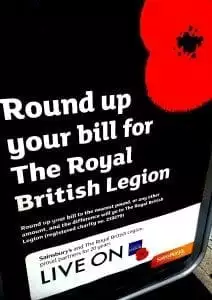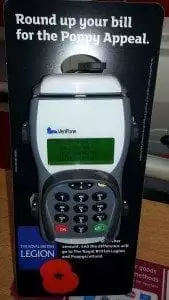There are so many ways to support the Poppy Appeal when you pop in to a Sainsbury’s
Having been directly involved with a range of £multi-million FMCG and retailer-based fundraising partnerships, I read about Give as you Live’s recent survey that suggested that 87% of Britons believe that retailers don’t support good causes, with a sceptical eye. Though I’m not privy to the methodology behind this research, I’m sure many retailers that do help causes raise millions upon millions each year might be forgiven an eye twitch or two too.
However, taking the research at face value, another key point was that a mere 13% of those surveyed could recall their favourite retailers providing any charitable support. Of course, low unprompted awareness is something many charities contend with, so it would be useful to see what questions were asked to obtain these results.
The big four grocers
Assuming that many would view one of the big four charity-supporting grocers as one of their favourites, there’s another concern: they would also have retained little of the messages being conveyed by the causes benefitting from such support. Or it might be that they had simply not been exposed to such messages at all. This represents a huge missed opportunity for causes to inform, educate and engage with prospective donors and beneficiaries. Raising money through such partnerships is great, but so is maximising such opportunities to raise awareness that prompts other actions and regular giving.
Advertisement
Whilst it’s clear, from my own experience, that some retailers aren’t going the extra mile for charities, despite the well-documented business benefits, it appears that those that do run significant community affairs programmes need to communicate such support more effectively.
For example, as well as incorporating mentions of their charity partnerships in their TV and press advertising, they have a myriad of other communication channels at their disposable; at the till, on receipts, shelf-edge and through direct interactions with customers through email and social media. As many companies increasingly seek to meet strategic business objectives through their charity relationships, if customers remain oblivious they might as well go back to the days of cheque-book philanthropy.
The charity partners also have a role to play promoting their corporate-community ventures through various communication channels such as donor newsletters, email, social media, special events and retail outlets. After all, these are the kind of benefits they promise to deliver when pitching for partner status (And don’t say you don’t make such promises cos I know you do!)
And a budget should be set aside for measuring stake-holders’ perceptions and recall of such ventures, providing a rich source of insight for both parties.
Good examples of charity/retail partnerships

Of course there have been some ground-breaking charity/retail partnerships recently. One of the best examples is Morrisons incredible £6m partnership with Save the Children that set new standards and included sponsoring ITV’s “Born to Shine” that culminated in a fundraising extravaganza for the charity.
A new one to watch is Tesco dropping its Charity of the Year programme to team up with Diabetes UK on a long-term partnership that ought to reach millions through its awareness-raising focus. That also has a fundraising target of £10m which ought to be achievable considering £12m was raised through its Charity of the Year stint with Cancer Research UK during 2012. And you’d have to be living in a very dark hole if you hadn’t come across M&S’s relationship with Oxfam and the award-winning concept of Shwopping.
But what’s captured my attention more recently is Sainsbury’s highly visible and broad spectrum of support for this year’s Poppy Appeal, during the company’s 19th year of support for The Royal British Legion.
As well as providing ample opportunities for customers to buy an iconic poppy, the programme includes sales-based fundraising promotions featuring the Red Poppy Mug and the eco-friendly jute poppy bag. Customers can also make a £1 donation at the store’s online grocery shop for orders delivered between 23 October – 11 November.
Another brilliant bread-making promotion sees Sainsbury’s donating 10% of the sale price of selected poppy inspired products including a Taste the Difference Poppy Seed Bloomer and Taste the Difference Gruyère and Poppy Seed Twists. Furthermore, it’s pledging the same level of donation based on sales of its Lemon & Poppy Seed Muffins sold in its instore cafés. What’s not to like?
And if all that hadn’t tempted you to support the Poppy Appeal whilst doing your shopping, at the end of your spree you can round up your bill to the nearest pound at the checkout. On this last point, I did ask Sainsbury’s if it matched customers’ rounded up donations but it doesn’t. Perhaps it will consider doing so in future years, setting a minimum and maximum target for matching.
Despite that missed opportunity for an even more memorable gesture, it’s still a commendable and skilfully branded partnership that appears to be going down very well with staff and customers.
And one I trust they will remember.
UPDATE 3/11/2014
Sainsbury’s is celebrating 20 years supporting The Royal British Legion by attempting to smash all previous amounts it’s raised during this year’s Poppy Appeal. The retailer hopes to achieve this by increasing its support across merchandise, in-store donations, and for the first time ever, a TV advert with striking animations to drive donations and raise awareness of the national cause.

Customers can, once more, support The Royal British Legion in various ways through Sainsbury’s from donating to a poppy collector, buying exclusive merchandise – including a tote bag by British designer Amanda Wakeley, rounding up their shopping bill at the till or making a £1 donation through online shopping.
Funds donated by Sainsbury’s customers and colleagues from last year alone amounted to over £4.5m and were used to support services provided to ex-service personnel and their families by The Royal British Legion, such as its Breaks Service, which provides adventure breaks for children and teenagers who can often feel isolated or to enabling a bereaved family to spend some time together.
The inclusion of a TV advert specifically focussing on the Poppy Appeal is, I believe, a first for any UK retailer. I think it’s a well-balanced and sensitive production and, in general, seems to be going down well on social media.
Of course, as is the fate of all corporate-community partnerships, there will be some that will accuse the retailer of “cashing in” on the affection and support the public has for the Poppy Appeal. However, the fact that the supermarket has supported the Royal British Legion for over twenty years should be enough to assuage such notions. It’s a partnership that’s grown from strength to strength, with RBL generating new funds via product tie-ups and Sainsbury’s making extensive use of in-store space and core seasonal advertising.
Indeed, as Britain marks the 100th anniversary of one of the costliest conflicts in history, I think it’s even more fitting that everyone, including companies, go the extra mile to remember and raise funds.
The TV element of this year’s Poppy Appeal is a prelude to Sainsbury’s forthcoming Christmas TV advert, also created in partnership with the Royal British Legion. As ever, once aired, social media pundits will then commence battle over whether it’s in good or bad taste.
Updated on 3 November 2014
John Thompson is director and consultant at Changing Business




